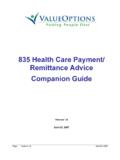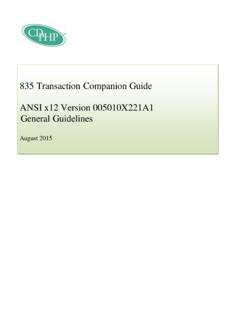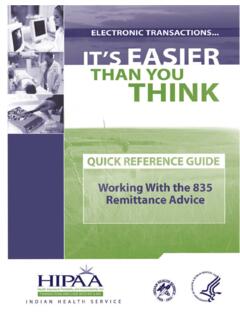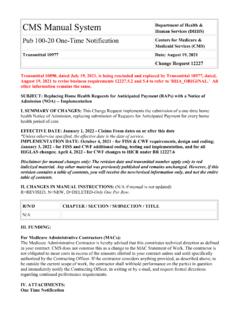Transcription of Remittance Advice Resources and FAQs - CMS
1 Remittance Advice Resources and faqs TABLE OF CONTENTS. The Centers for Medicare & Medicaid Services (CMS) prepared this Remittance Advice (RA) booklet for Medicare Providers to access RA information. This booklet contains information about RAs and allows different provider types to navigate easily to relevant topics. To go directly to a section, click on the topic below. General Information ..3. Reading an Institutional RA ..7. Reading a Professional RA ..9. Frequently Asked Questions ( faqs ) ..13. Resources /Embedded URL Table and Disclaimer ..15. Target Audience: Providers, Physicians, Suppliers, and Medicare Fee-For-Service Program (also known as Original Medicare). The Hyperlink Table, at the end of this document, provides the complete URL for each hyperlink.
2 Page 1 of 15. Remittance Advice Resources and faqs MLN Booklet GENERAL INFORMATION. MACs send claim adjudication and payment information to providers, suppliers, and billers using an Electronic Remittance Advice (ERA) or a Standard Paper Remittance (SPR) along with payments . These RAs give explanations and guidance as to whether Medicare made a payment on a claim and if the payment differs from what the provider submitted. The ERA or SPR conveys itemized information for each claim and/or service line enabling the provider to associate the adjudication decisions with those submitted claims/lines. The ERA or SPR, reports the reason and the value of each adjustment. Adjustments can happen at the claim, service line, or provider level. Institutional and Professional RAs Part A, Institutional Providers, submit claims to Medicare Administrative Contractors (MACs).
3 After the MACs process these claims, they generate an Institutional Remittance Advice (RA) as a companion to the payment or as an explanation of no payment. Part B, Professional Providers, submit claims to MACs. After the MACs process the claims, they generate a Professional RA as a companion to the payment or as an explanation of no payment. An ERA reports the adjustment reasons using standard codes. For any claim or service-line level adjustment, Medicare may use three sets of codes: 1. Claim Adjustment Group Code (Group Code). 2. Claim Adjustment Reason Code (CARC). 3. Remittance Advice Remark Code (RARC). Group Codes assign financial responsibility for the unpaid portion of the claim/service-line balance. A. Contractual Obligation (CO) Group Code assigns responsibility to the provider and Patient Responsibility (PR) Group Code assigns responsibility to the patient.
4 Providers may bill Medicare beneficiaries for an unpaid portion only when an adjustment shows Group Code PR. CARCs provide an overall explanation for the financial adjustment and RARCs supplement the CARCs with the addition of a more specific explanation. While providers get an ERA or SPR, Medicare beneficiaries get a Medicare Summary Notice (MSN) indicating how much financial responsibility the beneficiary incurs because of the claim. At the provider level, adjustments usually do not relate to any specific claim or service-line in the RA, and Provider Level Balance (PLB) reason codes explain the reason for the adjustment. Some examples of provider level adjustment are: 1. An increase in payment for interest due as a result of the late payment of a clean claim by Medicare 2.
5 A deduction from payment as a result of a prior overpayment 3. An increase in payment for any provider incentive plan Note: Medicare issues one check or Electronic Funds Transfer (EFT) when payment is due, representing all benefits due from Medicare for the claims itemized in an ERA or SPR. Page 2 of 15. Remittance Advice Resources and faqs MLN Booklet As a Payee you will use RA information as inputs to patient accounting system/Accounts Receivable (A/R) and general ledger applications. In addition, RA information may indicate a need for you to resubmit a claim with corrected information. RA information also indicates whether you can appeal the payment. ERA vs SPR. You may get an RA from Medicare as an ERA or as an SPR. Although the information on ERAs and SPRs is similar, the two formats are different.
6 The ERA offers some data and administrative efficiencies not available in an SPR. Additionally, an ERA can have more information than an SPR. For example, an SPR has two basic page layouts: the Claims Page and the Summary Page. However, an ERA has four page layouts: the All Claims Screen, Single Claim Screen, Bill Type Summary Screen, and Provider Payment Screen. ERAs can also be manipulated electronically into a variety of report formats. The Health Insurance Portability and Accountability Act (HIPAA) does not cover the SPR, so service-line information may not appear on some Institutional SPRs like it does on an ERA. The SPR shows the same lines, fields, and codes that are on the ERA, which helps you to make sure that the 835 balances at three levels (transaction, claim, and service line).
7 Health care professionals who are active in the Medicare Program and submit claims, may get an ERA. ERA. is an outbound Electronic Data Interchange (EDI) transaction from the payer that enables you to get payment information in an electronic file format. If you have software capability in place in your system, your MAC can automatically post an ERA file created by Medicare to your accounts receivable system. Once you have the ERA in place, the payment posting process is more efficient and accurate. There are advantages to using the ERA versus the SPR. Using an ERA saves time and increases productivity by providing electronic payment adjustment information that is portable, reusable, retrievable, and storable. Trading partners can exchange an ERA with much greater ease than an SPR ERA advantages include.
8 Faster communication and payment notification Faster account reconciliation through electronic posting Automation of follow-up action Generation of less paper Lower operating costs Ability to create various reports Ability to search for information on claims Ability to export data to other applications More detailed information Access to data in a variety of formats through free software supported by Medicare The amount payable for each claim and/or service line as well as each adjustment applied to either can be automatically posted to accounting or billing applications from an ERA, eliminating the time and cost for staff to post this information manually from an SPR. ERAs generally contain more detailed information than SPRs. Also, ERAs may enable providers to automate follow-up actions after getting an RA.
9 Page 3 of 15. Remittance Advice Resources and faqs MLN Booklet If you submit your claims on paper or if you send claims electronically and do not have your own submitter number but want to get ERAs directly, you must complete the Separate Remittance Agreement form. You may allow a billing service or clearinghouse to get the ERA files on your behalf by completing the Provider/. Submitter Agreement form. If you have questions, your MACs may have more information. Find their website at Note: MACs do not send SPRs if you have been getting ERAs for more than 31 days (Institutional Providers) and 45 days (Professional Providers) respectively. If you submit claims through a billing service or clearinghouse or a submitter/sender ID that is currently receiving ERAs, you will no longer get your SPR effective with the date of completion of the ERA setup.
10 Information in the ERA. The basic field, , data element, types in the RA can be alphabetic, numeric, or alphanumeric. The HIPAA- compliant Accredited Standards Committee (ASC) X12N 835 format standards define data elements that appear on all Medicare ERAs as Required or Situational. The required fields are mandatory for MACs to include in the ERA. Situational fields depends on data content and business context (Medicare requirements), and providers use them if the situation applies If your MAC bases payment on a procedure code, , Healthcare Common Procedure Coding System/Current Procedural Terminology (HCPCS/CPT) code, that is different from the procedure code you submitted on the claim, (for example, your MAC revised the HCPCS/CPT code during processing), both procedure code fields appear in the 835.

















